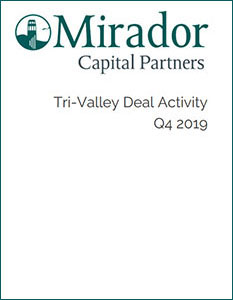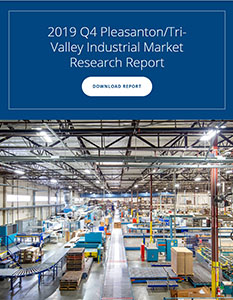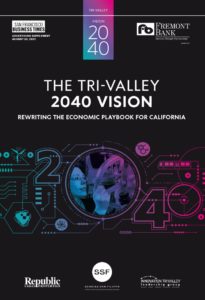Regional Reports
Download the San Francisco Business Times special supplement that was published in conjunction with Innovation Tri-Valley Leadership Group (ITV).
Download the San Francisco Business Times special supplement that was published in conjunction with Innovation Tri-Valley Leadership Group (ITV).

Tenants and Landlords: We Are All In This Together. Landlord and Tenant Relationships During COVID-19.

The Mirador View: Perspectives on the Tri-Valley. Download Our 2020 Research Report.

As the Tri-Valley’s premier investment management firm, we are actively engaged in our investments, clients and community.

The Tri-Valley industrial market finished an already strong 2019 with a very significant lease transaction to Amazon. The overall vacancy rate decreased significantly over the past 90 days by 34 percent, from 6.7 to 4.4 percent. The year-to-date net absorption ended on a very positive note, with 435,295 square feet absorbed for the year.

The fourth quarter experienced a slight uptick in vacancy to 10.2 percent from 9.9 percent in the previous quarter. With multiple tenants vacating blocks of space above 20,000 square feet, the fourth quarter reported a net absorption of negative 86,304 square feet.
 The attached report summarizes the fourth quarter of 2018 market activity for the I-580/I-680 Corridor (Tri-Valley) industrial, office, and retail markets and what we expect for the first quarter of 2019.
The attached report summarizes the fourth quarter of 2018 market activity for the I-580/I-680 Corridor (Tri-Valley) industrial, office, and retail markets and what we expect for the first quarter of 2019.
Tri-Valley Rising was published in 2014 with the aim of taking inventory of the Tri-Valley region’s assets and resources, explaining its impressive economic success, identifying challenges that could threaten to impede its future growth, and providing policy recommendations to ensure its continued vitality. Among the report’s findings were that the Tri-Valley’s innovation assets were driving its economy, high-value connections between the Tri-Valley and the broader region were growing, a high quality of life was a large part of the Tri-Valley’s competitive advantage, and improving transportation systems between the Tri-Valley and broader region would support growing economic activity and improve competitiveness.
This July 2018 update to Tri-Valley Rising builds on the findings and information presented in the first report, while also exploring more policy options for local and regional stakeholders to better connect and strengthen the Tri-Valley’s economy as it continues to grow.
Located in the geographic center of the San Francisco Bay Area, the Tri-Valley is both a hub of business and a highly desirable place to live. Encompassing the five cities of Danville, Dublin, Livermore, Pleasanton, and San Ramon, the Tri-Valley punches far above its weight in terms of economic power. With an annual output of $42 billion, the small region is an integral part of the Bay Area economy. Its institutional assets and history of entrepreneurship have brought it to the forefront of Bay Area innovation.
 The Tri-Valley is an integral component of the Bay Area economy. Situated on the east side of the San Francisco Bay Area and located within the I-580 gateway corridor, the Tri-Valley is a reference to its location that includes the Amador Valley, Livermore Valley, and San Ramon Valley. The Tri-Valley region encompasses the cities of Dublin, Livermore, and Pleasanton in Alameda County and the Town of Danville and the City of San Ramon in Contra Costa County. With its robust research and development infrastructure and its growing entrepreneurial environment, the Tri-Valley region is no longer just a nice place to live—it has become a vital node in the Bay Area innovation system.
The Tri-Valley is an integral component of the Bay Area economy. Situated on the east side of the San Francisco Bay Area and located within the I-580 gateway corridor, the Tri-Valley is a reference to its location that includes the Amador Valley, Livermore Valley, and San Ramon Valley. The Tri-Valley region encompasses the cities of Dublin, Livermore, and Pleasanton in Alameda County and the Town of Danville and the City of San Ramon in Contra Costa County. With its robust research and development infrastructure and its growing entrepreneurial environment, the Tri-Valley region is no longer just a nice place to live—it has become a vital node in the Bay Area innovation system.
The Tri-Valley’s highly educated residents work throughout the Bay Area. The area’s growing number of businesses and its two national laboratories collaborate with partners across the wider region. But physical constraints impeding the movement of people and goods pose a threat to the Tri-Valley’s ability to maximize its economic contribution to the larger region.
The more connected the Bay Area population is with the multiple job centers in the region, the more flexible the region’s economy can be in connecting skilled workers with appropriate jobs. Investing in the efficient movement of people is especially critical as the region’s housing costs grow and as residents are pushed out of job centers in search of more affordable housing options. Longer commute distances place new burdens on the region’s public transit systems and highways. And the highways linking the Central Valley with the Port of Oakland are becoming more congested as goods movement grows and agricultural exports increase.
We are Innovation Accelerators
 Innovation Tri-Valley (ITV) started as a commitment between key business leaders to organize an effort to interconnect the businesses, research labs, educational institutions and civic leaders in a common and aligned vision to fully leverage the assets and potential of the region. The group firmly believes that with a united effort we can accomplish more to help our regional businesses grow and scale, resulting in job growth and community vitality.
Innovation Tri-Valley (ITV) started as a commitment between key business leaders to organize an effort to interconnect the businesses, research labs, educational institutions and civic leaders in a common and aligned vision to fully leverage the assets and potential of the region. The group firmly believes that with a united effort we can accomplish more to help our regional businesses grow and scale, resulting in job growth and community vitality.
The Tri-Valley is endowed with world-class business assets. They include 11 of the top 50 companies by revenue in the entire Bay Area, the #1 largest company in revenue in the Bay Area, a high concentration of Gazelles (fast growing companies), two National Labs, and a workforce and student base that is as well-positioned and accomplished as the talent base in Silicon Valley. We also have a high quality of life, with a vibrant combination of wineries, restaurants, shopping areas, recreational parks and facilities, entertainment venues, and a Mediterranean climate.
 The major purpose of the “Innovation Potential in the Tri-Valley” report is to identify and analyze the assets of the five-city California region (Danville, Dublin, Livermore, Pleasanton and San Ramon) in the context of its innovation potential. The report provides a basis for developing the innovation plan for the region. It also provides the background data and analysis for further assessment of the regions potential as an innovation hub. The research was commissioned by the steering committee of the Innovation Tri-Valley Initiative. The steering comitee conducted the research in a relatively short four-week period and prepared this report.
The major purpose of the “Innovation Potential in the Tri-Valley” report is to identify and analyze the assets of the five-city California region (Danville, Dublin, Livermore, Pleasanton and San Ramon) in the context of its innovation potential. The report provides a basis for developing the innovation plan for the region. It also provides the background data and analysis for further assessment of the regions potential as an innovation hub. The research was commissioned by the steering committee of the Innovation Tri-Valley Initiative. The steering comitee conducted the research in a relatively short four-week period and prepared this report.





 Download Tri-Valley 2040 Vision – Rising to the Challenge and Shaping a Dynamic Future for the Tri-Valley
Download Tri-Valley 2040 Vision – Rising to the Challenge and Shaping a Dynamic Future for the Tri-Valley



